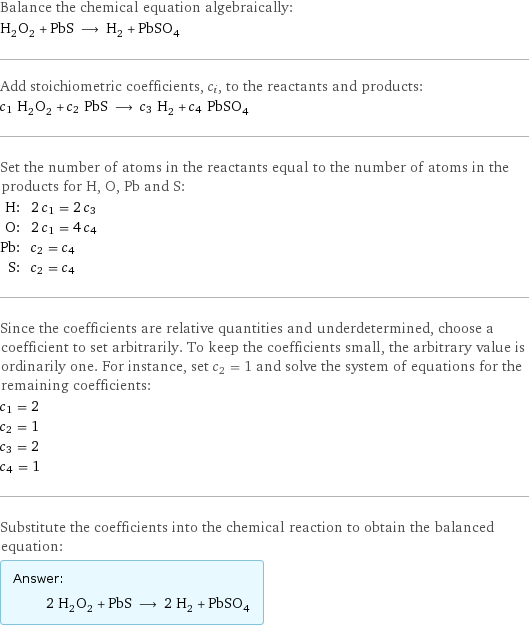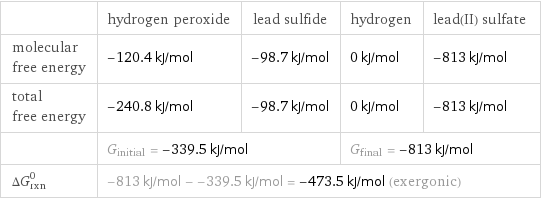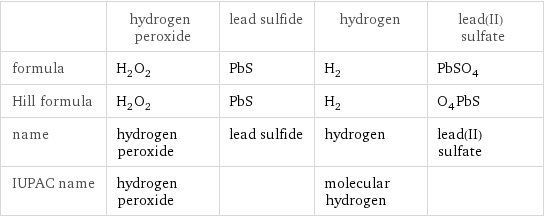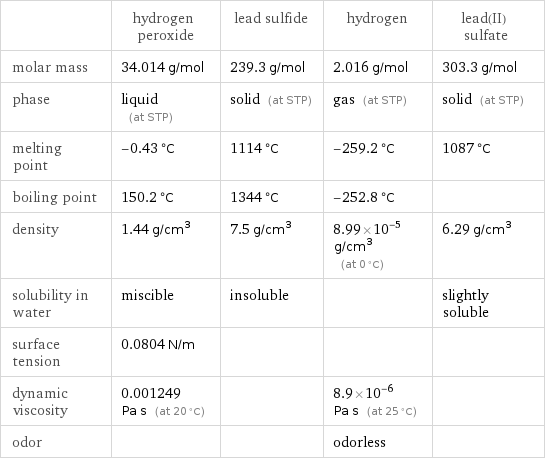Input interpretation

H_2O_2 hydrogen peroxide + PbS lead sulfide ⟶ H_2 hydrogen + PbSO_4 lead(II) sulfate
Balanced equation

Balance the chemical equation algebraically: H_2O_2 + PbS ⟶ H_2 + PbSO_4 Add stoichiometric coefficients, c_i, to the reactants and products: c_1 H_2O_2 + c_2 PbS ⟶ c_3 H_2 + c_4 PbSO_4 Set the number of atoms in the reactants equal to the number of atoms in the products for H, O, Pb and S: H: | 2 c_1 = 2 c_3 O: | 2 c_1 = 4 c_4 Pb: | c_2 = c_4 S: | c_2 = c_4 Since the coefficients are relative quantities and underdetermined, choose a coefficient to set arbitrarily. To keep the coefficients small, the arbitrary value is ordinarily one. For instance, set c_2 = 1 and solve the system of equations for the remaining coefficients: c_1 = 2 c_2 = 1 c_3 = 2 c_4 = 1 Substitute the coefficients into the chemical reaction to obtain the balanced equation: Answer: | | 2 H_2O_2 + PbS ⟶ 2 H_2 + PbSO_4
Structures

+ ⟶ +
Names

hydrogen peroxide + lead sulfide ⟶ hydrogen + lead(II) sulfate
Reaction thermodynamics
Gibbs free energy

| hydrogen peroxide | lead sulfide | hydrogen | lead(II) sulfate molecular free energy | -120.4 kJ/mol | -98.7 kJ/mol | 0 kJ/mol | -813 kJ/mol total free energy | -240.8 kJ/mol | -98.7 kJ/mol | 0 kJ/mol | -813 kJ/mol | G_initial = -339.5 kJ/mol | | G_final = -813 kJ/mol | ΔG_rxn^0 | -813 kJ/mol - -339.5 kJ/mol = -473.5 kJ/mol (exergonic) | | |
Equilibrium constant
![Construct the equilibrium constant, K, expression for: H_2O_2 + PbS ⟶ H_2 + PbSO_4 Plan: • Balance the chemical equation. • Determine the stoichiometric numbers. • Assemble the activity expression for each chemical species. • Use the activity expressions to build the equilibrium constant expression. Write the balanced chemical equation: 2 H_2O_2 + PbS ⟶ 2 H_2 + PbSO_4 Assign stoichiometric numbers, ν_i, using the stoichiometric coefficients, c_i, from the balanced chemical equation in the following manner: ν_i = -c_i for reactants and ν_i = c_i for products: chemical species | c_i | ν_i H_2O_2 | 2 | -2 PbS | 1 | -1 H_2 | 2 | 2 PbSO_4 | 1 | 1 Assemble the activity expressions accounting for the state of matter and ν_i: chemical species | c_i | ν_i | activity expression H_2O_2 | 2 | -2 | ([H2O2])^(-2) PbS | 1 | -1 | ([PbS])^(-1) H_2 | 2 | 2 | ([H2])^2 PbSO_4 | 1 | 1 | [PbSO4] The equilibrium constant symbol in the concentration basis is: K_c Mulitply the activity expressions to arrive at the K_c expression: Answer: | | K_c = ([H2O2])^(-2) ([PbS])^(-1) ([H2])^2 [PbSO4] = (([H2])^2 [PbSO4])/(([H2O2])^2 [PbS])](../image_source/4dac5939b109d0498826078b72acc789.png)
Construct the equilibrium constant, K, expression for: H_2O_2 + PbS ⟶ H_2 + PbSO_4 Plan: • Balance the chemical equation. • Determine the stoichiometric numbers. • Assemble the activity expression for each chemical species. • Use the activity expressions to build the equilibrium constant expression. Write the balanced chemical equation: 2 H_2O_2 + PbS ⟶ 2 H_2 + PbSO_4 Assign stoichiometric numbers, ν_i, using the stoichiometric coefficients, c_i, from the balanced chemical equation in the following manner: ν_i = -c_i for reactants and ν_i = c_i for products: chemical species | c_i | ν_i H_2O_2 | 2 | -2 PbS | 1 | -1 H_2 | 2 | 2 PbSO_4 | 1 | 1 Assemble the activity expressions accounting for the state of matter and ν_i: chemical species | c_i | ν_i | activity expression H_2O_2 | 2 | -2 | ([H2O2])^(-2) PbS | 1 | -1 | ([PbS])^(-1) H_2 | 2 | 2 | ([H2])^2 PbSO_4 | 1 | 1 | [PbSO4] The equilibrium constant symbol in the concentration basis is: K_c Mulitply the activity expressions to arrive at the K_c expression: Answer: | | K_c = ([H2O2])^(-2) ([PbS])^(-1) ([H2])^2 [PbSO4] = (([H2])^2 [PbSO4])/(([H2O2])^2 [PbS])
Rate of reaction
![Construct the rate of reaction expression for: H_2O_2 + PbS ⟶ H_2 + PbSO_4 Plan: • Balance the chemical equation. • Determine the stoichiometric numbers. • Assemble the rate term for each chemical species. • Write the rate of reaction expression. Write the balanced chemical equation: 2 H_2O_2 + PbS ⟶ 2 H_2 + PbSO_4 Assign stoichiometric numbers, ν_i, using the stoichiometric coefficients, c_i, from the balanced chemical equation in the following manner: ν_i = -c_i for reactants and ν_i = c_i for products: chemical species | c_i | ν_i H_2O_2 | 2 | -2 PbS | 1 | -1 H_2 | 2 | 2 PbSO_4 | 1 | 1 The rate term for each chemical species, B_i, is 1/ν_i(Δ[B_i])/(Δt) where [B_i] is the amount concentration and t is time: chemical species | c_i | ν_i | rate term H_2O_2 | 2 | -2 | -1/2 (Δ[H2O2])/(Δt) PbS | 1 | -1 | -(Δ[PbS])/(Δt) H_2 | 2 | 2 | 1/2 (Δ[H2])/(Δt) PbSO_4 | 1 | 1 | (Δ[PbSO4])/(Δt) (for infinitesimal rate of change, replace Δ with d) Set the rate terms equal to each other to arrive at the rate expression: Answer: | | rate = -1/2 (Δ[H2O2])/(Δt) = -(Δ[PbS])/(Δt) = 1/2 (Δ[H2])/(Δt) = (Δ[PbSO4])/(Δt) (assuming constant volume and no accumulation of intermediates or side products)](../image_source/7fb452ca0c102bdc6418ba3c47e5b9a0.png)
Construct the rate of reaction expression for: H_2O_2 + PbS ⟶ H_2 + PbSO_4 Plan: • Balance the chemical equation. • Determine the stoichiometric numbers. • Assemble the rate term for each chemical species. • Write the rate of reaction expression. Write the balanced chemical equation: 2 H_2O_2 + PbS ⟶ 2 H_2 + PbSO_4 Assign stoichiometric numbers, ν_i, using the stoichiometric coefficients, c_i, from the balanced chemical equation in the following manner: ν_i = -c_i for reactants and ν_i = c_i for products: chemical species | c_i | ν_i H_2O_2 | 2 | -2 PbS | 1 | -1 H_2 | 2 | 2 PbSO_4 | 1 | 1 The rate term for each chemical species, B_i, is 1/ν_i(Δ[B_i])/(Δt) where [B_i] is the amount concentration and t is time: chemical species | c_i | ν_i | rate term H_2O_2 | 2 | -2 | -1/2 (Δ[H2O2])/(Δt) PbS | 1 | -1 | -(Δ[PbS])/(Δt) H_2 | 2 | 2 | 1/2 (Δ[H2])/(Δt) PbSO_4 | 1 | 1 | (Δ[PbSO4])/(Δt) (for infinitesimal rate of change, replace Δ with d) Set the rate terms equal to each other to arrive at the rate expression: Answer: | | rate = -1/2 (Δ[H2O2])/(Δt) = -(Δ[PbS])/(Δt) = 1/2 (Δ[H2])/(Δt) = (Δ[PbSO4])/(Δt) (assuming constant volume and no accumulation of intermediates or side products)
Chemical names and formulas

| hydrogen peroxide | lead sulfide | hydrogen | lead(II) sulfate formula | H_2O_2 | PbS | H_2 | PbSO_4 Hill formula | H_2O_2 | PbS | H_2 | O_4PbS name | hydrogen peroxide | lead sulfide | hydrogen | lead(II) sulfate IUPAC name | hydrogen peroxide | | molecular hydrogen |
Substance properties

| hydrogen peroxide | lead sulfide | hydrogen | lead(II) sulfate molar mass | 34.014 g/mol | 239.3 g/mol | 2.016 g/mol | 303.3 g/mol phase | liquid (at STP) | solid (at STP) | gas (at STP) | solid (at STP) melting point | -0.43 °C | 1114 °C | -259.2 °C | 1087 °C boiling point | 150.2 °C | 1344 °C | -252.8 °C | density | 1.44 g/cm^3 | 7.5 g/cm^3 | 8.99×10^-5 g/cm^3 (at 0 °C) | 6.29 g/cm^3 solubility in water | miscible | insoluble | | slightly soluble surface tension | 0.0804 N/m | | | dynamic viscosity | 0.001249 Pa s (at 20 °C) | | 8.9×10^-6 Pa s (at 25 °C) | odor | | | odorless |
Units
